Digital Literacy Analysis Essay: Education Policies and Impact
VerifiedAdded on 2021/02/21
|10
|3347
|332
Essay
AI Summary
This essay critically analyzes digital literacy within the context of education, exploring its rationale, impact, and the need for concern among governments, educational systems, teachers, and the community. The essay delves into the pressures, risks, and benefits surrounding digital literacy, examining responses and analyzing various educational policies. It highlights the importance of digital literacy in modern learning, emphasizing the need for schools to adapt their teaching methods to keep pace with technological advancements. The analysis covers the influence of technology on education, the role of ICT policies, and the importance of teacher guidance in fostering digital skills. It also touches upon the potential misuse of technology by students and the importance of proper implementation to enhance learning and future prospects. The essay emphasizes the need for strategic utilization of digital media and the importance of addressing the challenges associated with digital literacy to ensure students are well-prepared for the digital world. The essay concludes by discussing the impact of educational policies, focusing on ICT and digital policies, and their role in improving students' skills and knowledge.
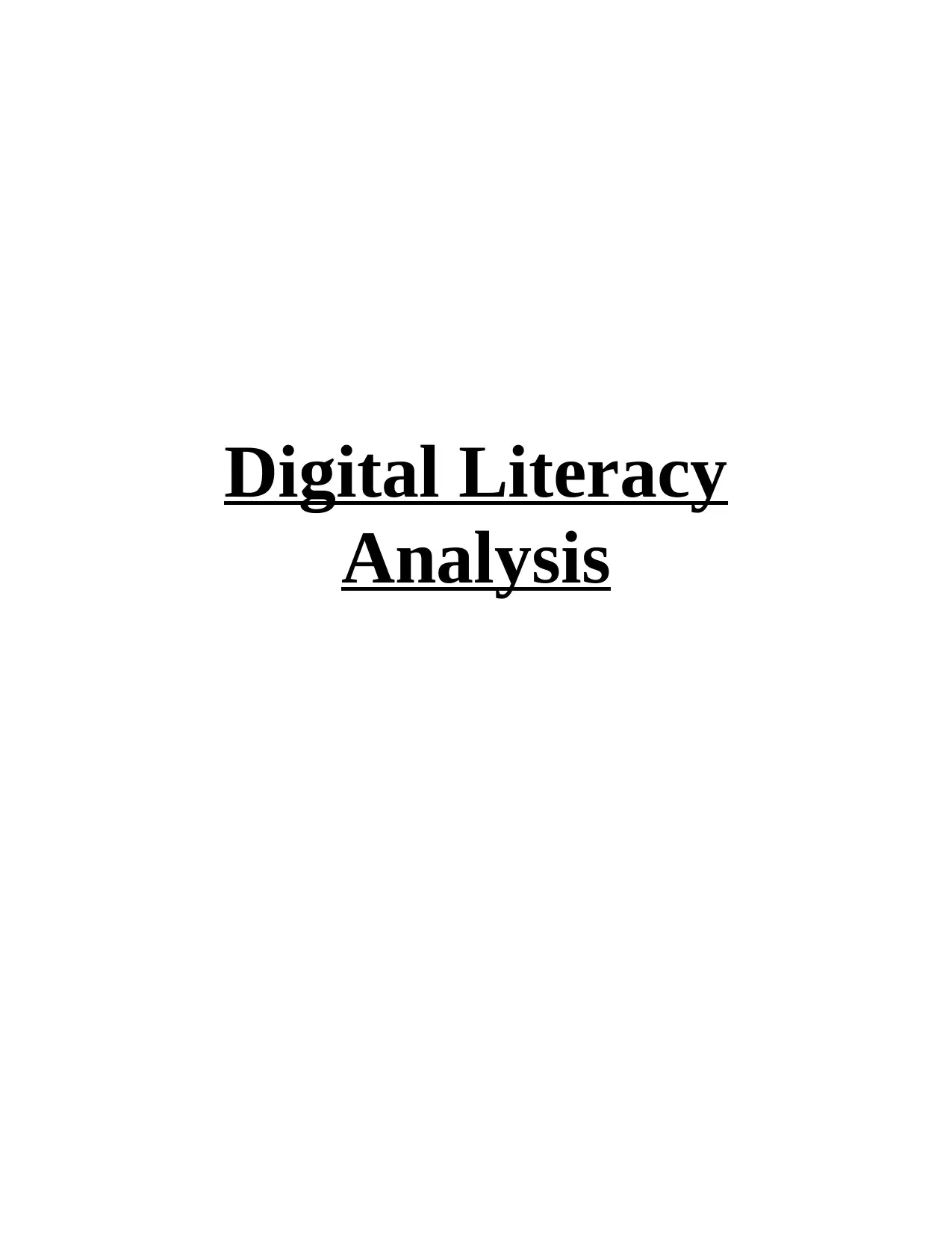
Digital Literacy
Analysis
Analysis
Paraphrase This Document
Need a fresh take? Get an instant paraphrase of this document with our AI Paraphraser
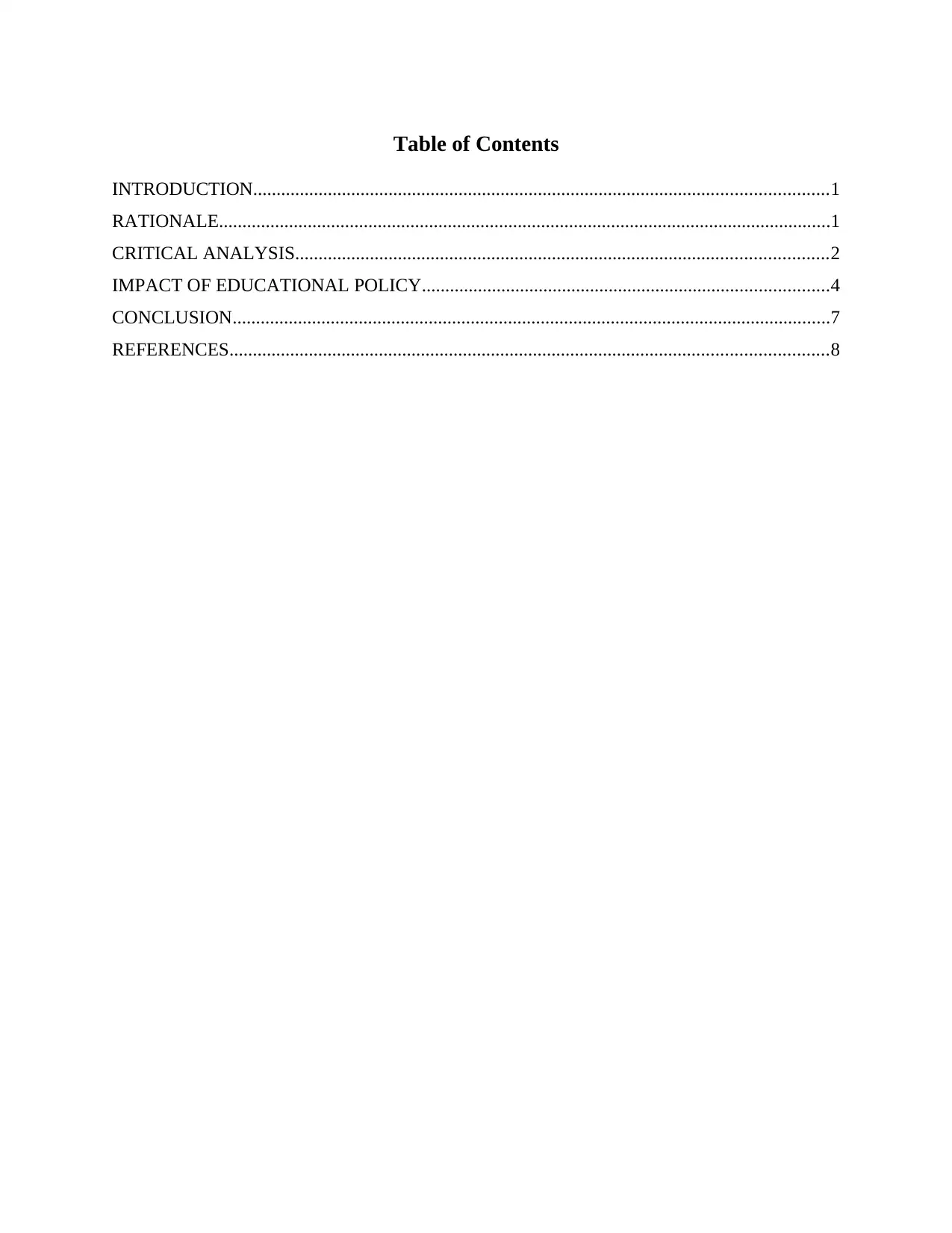
Table of Contents
INTRODUCTION...........................................................................................................................1
RATIONALE...................................................................................................................................1
CRITICAL ANALYSIS..................................................................................................................2
IMPACT OF EDUCATIONAL POLICY.......................................................................................4
CONCLUSION................................................................................................................................7
REFERENCES................................................................................................................................8
INTRODUCTION...........................................................................................................................1
RATIONALE...................................................................................................................................1
CRITICAL ANALYSIS..................................................................................................................2
IMPACT OF EDUCATIONAL POLICY.......................................................................................4
CONCLUSION................................................................................................................................7
REFERENCES................................................................................................................................8
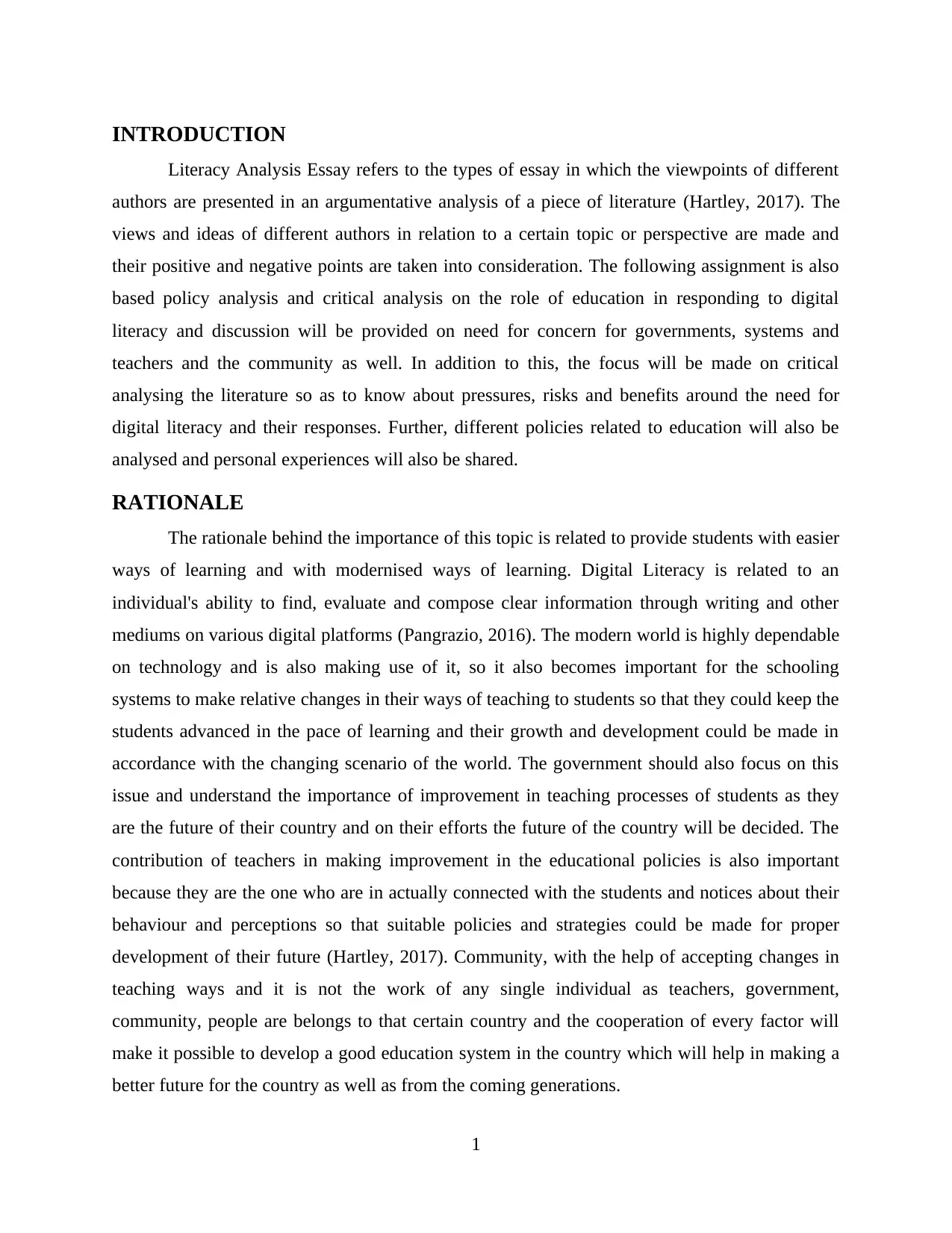
INTRODUCTION
Literacy Analysis Essay refers to the types of essay in which the viewpoints of different
authors are presented in an argumentative analysis of a piece of literature (Hartley, 2017). The
views and ideas of different authors in relation to a certain topic or perspective are made and
their positive and negative points are taken into consideration. The following assignment is also
based policy analysis and critical analysis on the role of education in responding to digital
literacy and discussion will be provided on need for concern for governments, systems and
teachers and the community as well. In addition to this, the focus will be made on critical
analysing the literature so as to know about pressures, risks and benefits around the need for
digital literacy and their responses. Further, different policies related to education will also be
analysed and personal experiences will also be shared.
RATIONALE
The rationale behind the importance of this topic is related to provide students with easier
ways of learning and with modernised ways of learning. Digital Literacy is related to an
individual's ability to find, evaluate and compose clear information through writing and other
mediums on various digital platforms (Pangrazio, 2016). The modern world is highly dependable
on technology and is also making use of it, so it also becomes important for the schooling
systems to make relative changes in their ways of teaching to students so that they could keep the
students advanced in the pace of learning and their growth and development could be made in
accordance with the changing scenario of the world. The government should also focus on this
issue and understand the importance of improvement in teaching processes of students as they
are the future of their country and on their efforts the future of the country will be decided. The
contribution of teachers in making improvement in the educational policies is also important
because they are the one who are in actually connected with the students and notices about their
behaviour and perceptions so that suitable policies and strategies could be made for proper
development of their future (Hartley, 2017). Community, with the help of accepting changes in
teaching ways and it is not the work of any single individual as teachers, government,
community, people are belongs to that certain country and the cooperation of every factor will
make it possible to develop a good education system in the country which will help in making a
better future for the country as well as from the coming generations.
1
Literacy Analysis Essay refers to the types of essay in which the viewpoints of different
authors are presented in an argumentative analysis of a piece of literature (Hartley, 2017). The
views and ideas of different authors in relation to a certain topic or perspective are made and
their positive and negative points are taken into consideration. The following assignment is also
based policy analysis and critical analysis on the role of education in responding to digital
literacy and discussion will be provided on need for concern for governments, systems and
teachers and the community as well. In addition to this, the focus will be made on critical
analysing the literature so as to know about pressures, risks and benefits around the need for
digital literacy and their responses. Further, different policies related to education will also be
analysed and personal experiences will also be shared.
RATIONALE
The rationale behind the importance of this topic is related to provide students with easier
ways of learning and with modernised ways of learning. Digital Literacy is related to an
individual's ability to find, evaluate and compose clear information through writing and other
mediums on various digital platforms (Pangrazio, 2016). The modern world is highly dependable
on technology and is also making use of it, so it also becomes important for the schooling
systems to make relative changes in their ways of teaching to students so that they could keep the
students advanced in the pace of learning and their growth and development could be made in
accordance with the changing scenario of the world. The government should also focus on this
issue and understand the importance of improvement in teaching processes of students as they
are the future of their country and on their efforts the future of the country will be decided. The
contribution of teachers in making improvement in the educational policies is also important
because they are the one who are in actually connected with the students and notices about their
behaviour and perceptions so that suitable policies and strategies could be made for proper
development of their future (Hartley, 2017). Community, with the help of accepting changes in
teaching ways and it is not the work of any single individual as teachers, government,
community, people are belongs to that certain country and the cooperation of every factor will
make it possible to develop a good education system in the country which will help in making a
better future for the country as well as from the coming generations.
1
⊘ This is a preview!⊘
Do you want full access?
Subscribe today to unlock all pages.

Trusted by 1+ million students worldwide
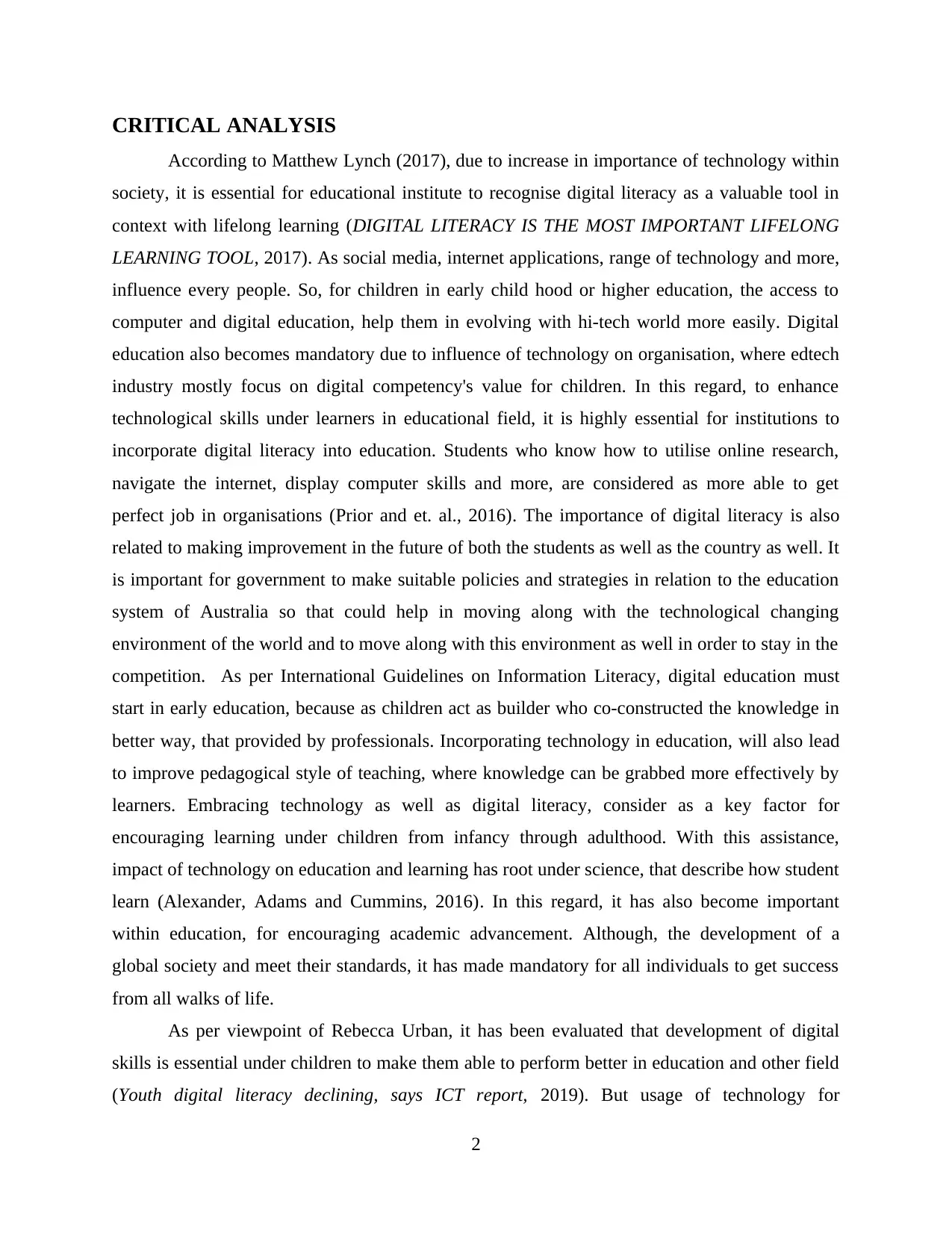
CRITICAL ANALYSIS
According to Matthew Lynch (2017), due to increase in importance of technology within
society, it is essential for educational institute to recognise digital literacy as a valuable tool in
context with lifelong learning (DIGITAL LITERACY IS THE MOST IMPORTANT LIFELONG
LEARNING TOOL, 2017). As social media, internet applications, range of technology and more,
influence every people. So, for children in early child hood or higher education, the access to
computer and digital education, help them in evolving with hi-tech world more easily. Digital
education also becomes mandatory due to influence of technology on organisation, where edtech
industry mostly focus on digital competency's value for children. In this regard, to enhance
technological skills under learners in educational field, it is highly essential for institutions to
incorporate digital literacy into education. Students who know how to utilise online research,
navigate the internet, display computer skills and more, are considered as more able to get
perfect job in organisations (Prior and et. al., 2016). The importance of digital literacy is also
related to making improvement in the future of both the students as well as the country as well. It
is important for government to make suitable policies and strategies in relation to the education
system of Australia so that could help in moving along with the technological changing
environment of the world and to move along with this environment as well in order to stay in the
competition. As per International Guidelines on Information Literacy, digital education must
start in early education, because as children act as builder who co-constructed the knowledge in
better way, that provided by professionals. Incorporating technology in education, will also lead
to improve pedagogical style of teaching, where knowledge can be grabbed more effectively by
learners. Embracing technology as well as digital literacy, consider as a key factor for
encouraging learning under children from infancy through adulthood. With this assistance,
impact of technology on education and learning has root under science, that describe how student
learn (Alexander, Adams and Cummins, 2016). In this regard, it has also become important
within education, for encouraging academic advancement. Although, the development of a
global society and meet their standards, it has made mandatory for all individuals to get success
from all walks of life.
As per viewpoint of Rebecca Urban, it has been evaluated that development of digital
skills is essential under children to make them able to perform better in education and other field
(Youth digital literacy declining, says ICT report, 2019). But usage of technology for
2
According to Matthew Lynch (2017), due to increase in importance of technology within
society, it is essential for educational institute to recognise digital literacy as a valuable tool in
context with lifelong learning (DIGITAL LITERACY IS THE MOST IMPORTANT LIFELONG
LEARNING TOOL, 2017). As social media, internet applications, range of technology and more,
influence every people. So, for children in early child hood or higher education, the access to
computer and digital education, help them in evolving with hi-tech world more easily. Digital
education also becomes mandatory due to influence of technology on organisation, where edtech
industry mostly focus on digital competency's value for children. In this regard, to enhance
technological skills under learners in educational field, it is highly essential for institutions to
incorporate digital literacy into education. Students who know how to utilise online research,
navigate the internet, display computer skills and more, are considered as more able to get
perfect job in organisations (Prior and et. al., 2016). The importance of digital literacy is also
related to making improvement in the future of both the students as well as the country as well. It
is important for government to make suitable policies and strategies in relation to the education
system of Australia so that could help in moving along with the technological changing
environment of the world and to move along with this environment as well in order to stay in the
competition. As per International Guidelines on Information Literacy, digital education must
start in early education, because as children act as builder who co-constructed the knowledge in
better way, that provided by professionals. Incorporating technology in education, will also lead
to improve pedagogical style of teaching, where knowledge can be grabbed more effectively by
learners. Embracing technology as well as digital literacy, consider as a key factor for
encouraging learning under children from infancy through adulthood. With this assistance,
impact of technology on education and learning has root under science, that describe how student
learn (Alexander, Adams and Cummins, 2016). In this regard, it has also become important
within education, for encouraging academic advancement. Although, the development of a
global society and meet their standards, it has made mandatory for all individuals to get success
from all walks of life.
As per viewpoint of Rebecca Urban, it has been evaluated that development of digital
skills is essential under children to make them able to perform better in education and other field
(Youth digital literacy declining, says ICT report, 2019). But usage of technology for
2
Paraphrase This Document
Need a fresh take? Get an instant paraphrase of this document with our AI Paraphraser
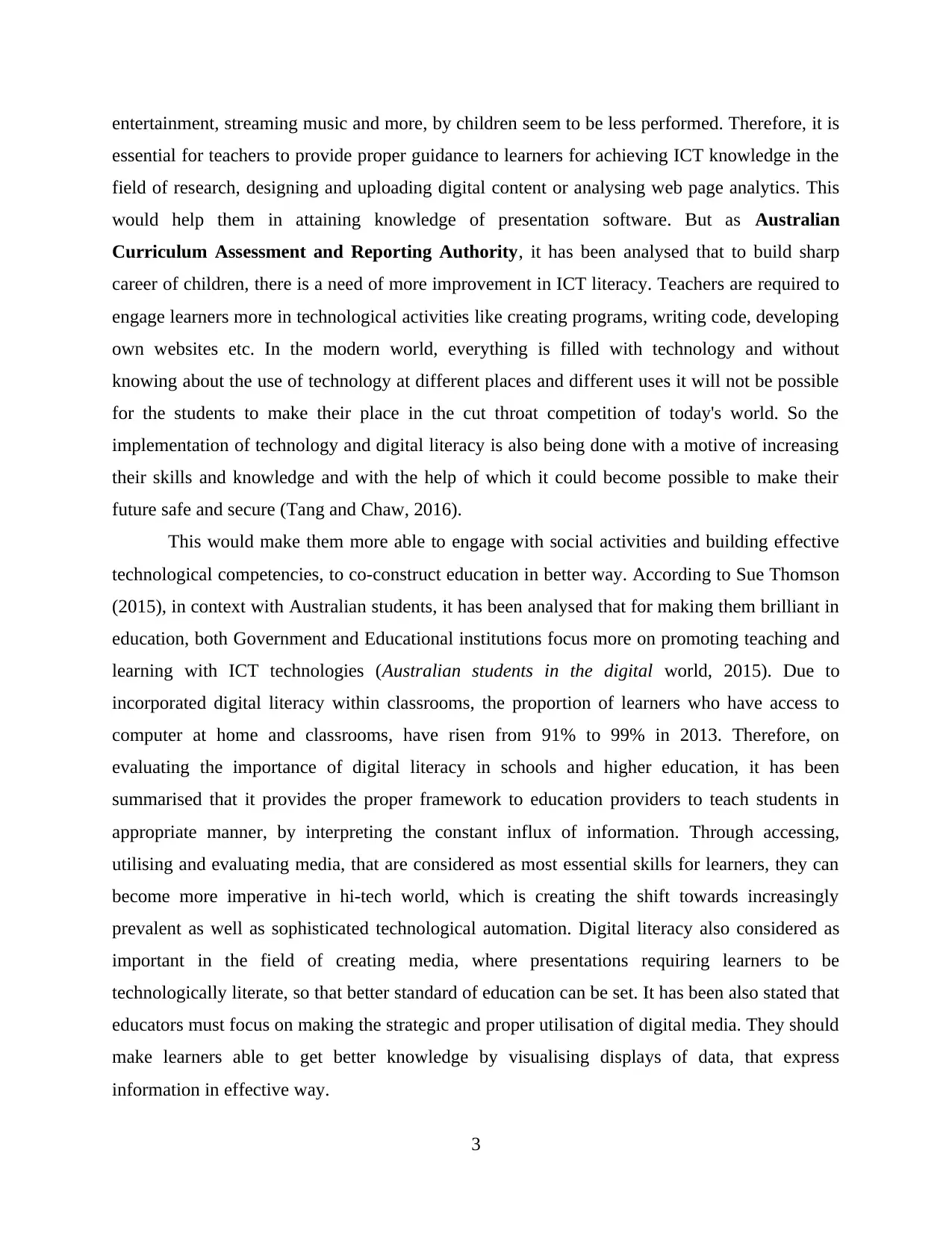
entertainment, streaming music and more, by children seem to be less performed. Therefore, it is
essential for teachers to provide proper guidance to learners for achieving ICT knowledge in the
field of research, designing and uploading digital content or analysing web page analytics. This
would help them in attaining knowledge of presentation software. But as Australian
Curriculum Assessment and Reporting Authority, it has been analysed that to build sharp
career of children, there is a need of more improvement in ICT literacy. Teachers are required to
engage learners more in technological activities like creating programs, writing code, developing
own websites etc. In the modern world, everything is filled with technology and without
knowing about the use of technology at different places and different uses it will not be possible
for the students to make their place in the cut throat competition of today's world. So the
implementation of technology and digital literacy is also being done with a motive of increasing
their skills and knowledge and with the help of which it could become possible to make their
future safe and secure (Tang and Chaw, 2016).
This would make them more able to engage with social activities and building effective
technological competencies, to co-construct education in better way. According to Sue Thomson
(2015), in context with Australian students, it has been analysed that for making them brilliant in
education, both Government and Educational institutions focus more on promoting teaching and
learning with ICT technologies (Australian students in the digital world, 2015). Due to
incorporated digital literacy within classrooms, the proportion of learners who have access to
computer at home and classrooms, have risen from 91% to 99% in 2013. Therefore, on
evaluating the importance of digital literacy in schools and higher education, it has been
summarised that it provides the proper framework to education providers to teach students in
appropriate manner, by interpreting the constant influx of information. Through accessing,
utilising and evaluating media, that are considered as most essential skills for learners, they can
become more imperative in hi-tech world, which is creating the shift towards increasingly
prevalent as well as sophisticated technological automation. Digital literacy also considered as
important in the field of creating media, where presentations requiring learners to be
technologically literate, so that better standard of education can be set. It has been also stated that
educators must focus on making the strategic and proper utilisation of digital media. They should
make learners able to get better knowledge by visualising displays of data, that express
information in effective way.
3
essential for teachers to provide proper guidance to learners for achieving ICT knowledge in the
field of research, designing and uploading digital content or analysing web page analytics. This
would help them in attaining knowledge of presentation software. But as Australian
Curriculum Assessment and Reporting Authority, it has been analysed that to build sharp
career of children, there is a need of more improvement in ICT literacy. Teachers are required to
engage learners more in technological activities like creating programs, writing code, developing
own websites etc. In the modern world, everything is filled with technology and without
knowing about the use of technology at different places and different uses it will not be possible
for the students to make their place in the cut throat competition of today's world. So the
implementation of technology and digital literacy is also being done with a motive of increasing
their skills and knowledge and with the help of which it could become possible to make their
future safe and secure (Tang and Chaw, 2016).
This would make them more able to engage with social activities and building effective
technological competencies, to co-construct education in better way. According to Sue Thomson
(2015), in context with Australian students, it has been analysed that for making them brilliant in
education, both Government and Educational institutions focus more on promoting teaching and
learning with ICT technologies (Australian students in the digital world, 2015). Due to
incorporated digital literacy within classrooms, the proportion of learners who have access to
computer at home and classrooms, have risen from 91% to 99% in 2013. Therefore, on
evaluating the importance of digital literacy in schools and higher education, it has been
summarised that it provides the proper framework to education providers to teach students in
appropriate manner, by interpreting the constant influx of information. Through accessing,
utilising and evaluating media, that are considered as most essential skills for learners, they can
become more imperative in hi-tech world, which is creating the shift towards increasingly
prevalent as well as sophisticated technological automation. Digital literacy also considered as
important in the field of creating media, where presentations requiring learners to be
technologically literate, so that better standard of education can be set. It has been also stated that
educators must focus on making the strategic and proper utilisation of digital media. They should
make learners able to get better knowledge by visualising displays of data, that express
information in effective way.
3
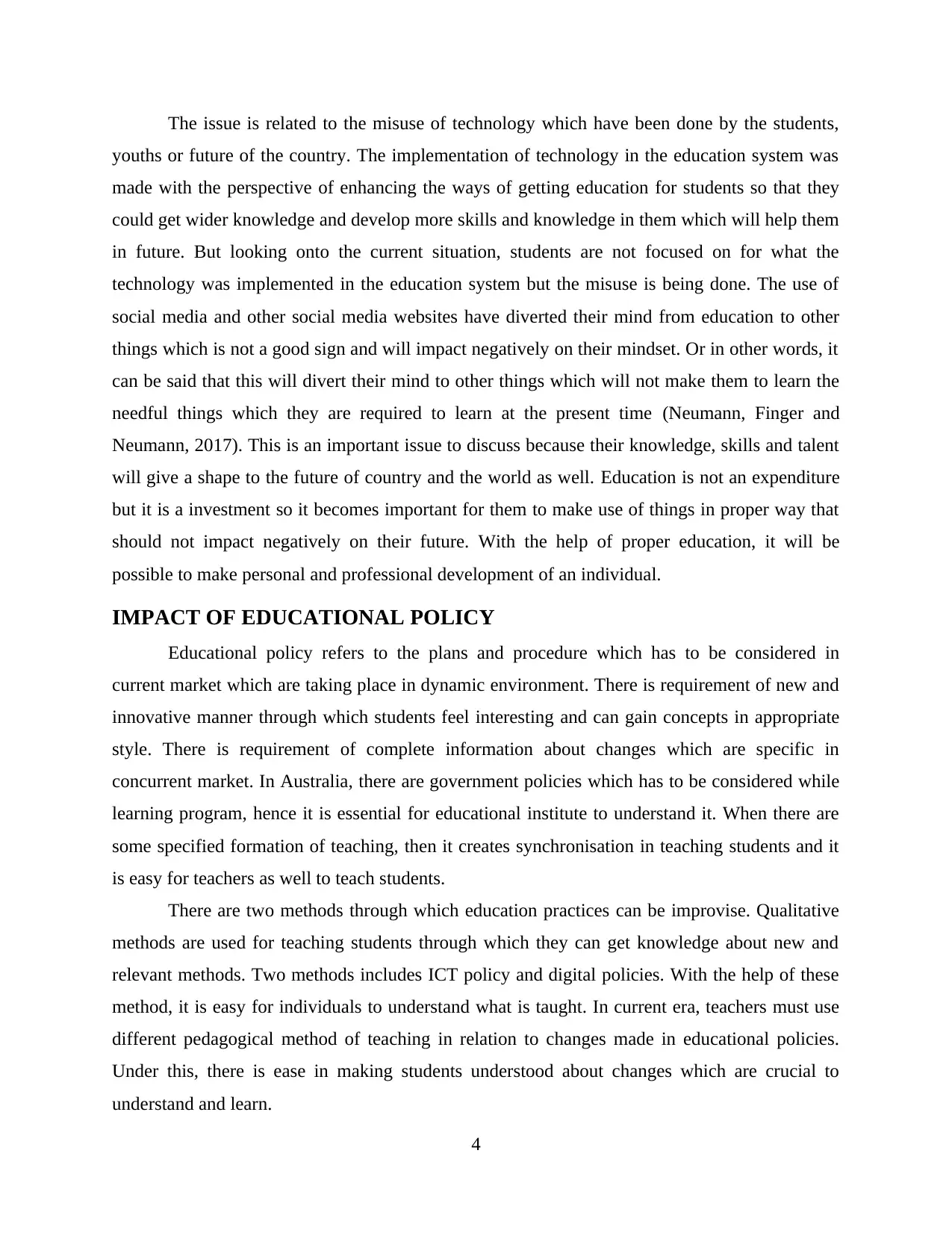
The issue is related to the misuse of technology which have been done by the students,
youths or future of the country. The implementation of technology in the education system was
made with the perspective of enhancing the ways of getting education for students so that they
could get wider knowledge and develop more skills and knowledge in them which will help them
in future. But looking onto the current situation, students are not focused on for what the
technology was implemented in the education system but the misuse is being done. The use of
social media and other social media websites have diverted their mind from education to other
things which is not a good sign and will impact negatively on their mindset. Or in other words, it
can be said that this will divert their mind to other things which will not make them to learn the
needful things which they are required to learn at the present time (Neumann, Finger and
Neumann, 2017). This is an important issue to discuss because their knowledge, skills and talent
will give a shape to the future of country and the world as well. Education is not an expenditure
but it is a investment so it becomes important for them to make use of things in proper way that
should not impact negatively on their future. With the help of proper education, it will be
possible to make personal and professional development of an individual.
IMPACT OF EDUCATIONAL POLICY
Educational policy refers to the plans and procedure which has to be considered in
current market which are taking place in dynamic environment. There is requirement of new and
innovative manner through which students feel interesting and can gain concepts in appropriate
style. There is requirement of complete information about changes which are specific in
concurrent market. In Australia, there are government policies which has to be considered while
learning program, hence it is essential for educational institute to understand it. When there are
some specified formation of teaching, then it creates synchronisation in teaching students and it
is easy for teachers as well to teach students.
There are two methods through which education practices can be improvise. Qualitative
methods are used for teaching students through which they can get knowledge about new and
relevant methods. Two methods includes ICT policy and digital policies. With the help of these
method, it is easy for individuals to understand what is taught. In current era, teachers must use
different pedagogical method of teaching in relation to changes made in educational policies.
Under this, there is ease in making students understood about changes which are crucial to
understand and learn.
4
youths or future of the country. The implementation of technology in the education system was
made with the perspective of enhancing the ways of getting education for students so that they
could get wider knowledge and develop more skills and knowledge in them which will help them
in future. But looking onto the current situation, students are not focused on for what the
technology was implemented in the education system but the misuse is being done. The use of
social media and other social media websites have diverted their mind from education to other
things which is not a good sign and will impact negatively on their mindset. Or in other words, it
can be said that this will divert their mind to other things which will not make them to learn the
needful things which they are required to learn at the present time (Neumann, Finger and
Neumann, 2017). This is an important issue to discuss because their knowledge, skills and talent
will give a shape to the future of country and the world as well. Education is not an expenditure
but it is a investment so it becomes important for them to make use of things in proper way that
should not impact negatively on their future. With the help of proper education, it will be
possible to make personal and professional development of an individual.
IMPACT OF EDUCATIONAL POLICY
Educational policy refers to the plans and procedure which has to be considered in
current market which are taking place in dynamic environment. There is requirement of new and
innovative manner through which students feel interesting and can gain concepts in appropriate
style. There is requirement of complete information about changes which are specific in
concurrent market. In Australia, there are government policies which has to be considered while
learning program, hence it is essential for educational institute to understand it. When there are
some specified formation of teaching, then it creates synchronisation in teaching students and it
is easy for teachers as well to teach students.
There are two methods through which education practices can be improvise. Qualitative
methods are used for teaching students through which they can get knowledge about new and
relevant methods. Two methods includes ICT policy and digital policies. With the help of these
method, it is easy for individuals to understand what is taught. In current era, teachers must use
different pedagogical method of teaching in relation to changes made in educational policies.
Under this, there is ease in making students understood about changes which are crucial to
understand and learn.
4
⊘ This is a preview!⊘
Do you want full access?
Subscribe today to unlock all pages.

Trusted by 1+ million students worldwide
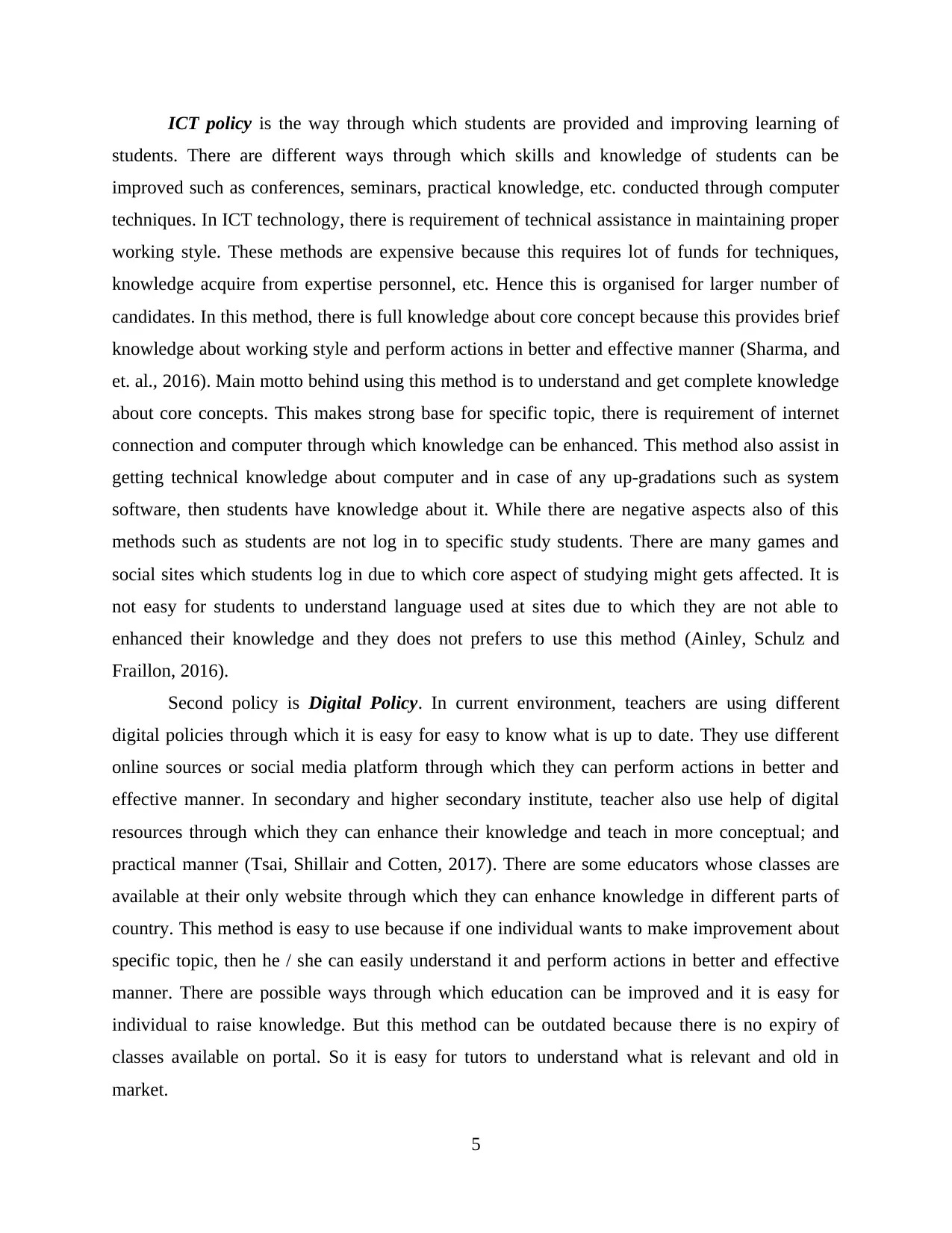
ICT policy is the way through which students are provided and improving learning of
students. There are different ways through which skills and knowledge of students can be
improved such as conferences, seminars, practical knowledge, etc. conducted through computer
techniques. In ICT technology, there is requirement of technical assistance in maintaining proper
working style. These methods are expensive because this requires lot of funds for techniques,
knowledge acquire from expertise personnel, etc. Hence this is organised for larger number of
candidates. In this method, there is full knowledge about core concept because this provides brief
knowledge about working style and perform actions in better and effective manner (Sharma, and
et. al., 2016). Main motto behind using this method is to understand and get complete knowledge
about core concepts. This makes strong base for specific topic, there is requirement of internet
connection and computer through which knowledge can be enhanced. This method also assist in
getting technical knowledge about computer and in case of any up-gradations such as system
software, then students have knowledge about it. While there are negative aspects also of this
methods such as students are not log in to specific study students. There are many games and
social sites which students log in due to which core aspect of studying might gets affected. It is
not easy for students to understand language used at sites due to which they are not able to
enhanced their knowledge and they does not prefers to use this method (Ainley, Schulz and
Fraillon, 2016).
Second policy is Digital Policy. In current environment, teachers are using different
digital policies through which it is easy for easy to know what is up to date. They use different
online sources or social media platform through which they can perform actions in better and
effective manner. In secondary and higher secondary institute, teacher also use help of digital
resources through which they can enhance their knowledge and teach in more conceptual; and
practical manner (Tsai, Shillair and Cotten, 2017). There are some educators whose classes are
available at their only website through which they can enhance knowledge in different parts of
country. This method is easy to use because if one individual wants to make improvement about
specific topic, then he / she can easily understand it and perform actions in better and effective
manner. There are possible ways through which education can be improved and it is easy for
individual to raise knowledge. But this method can be outdated because there is no expiry of
classes available on portal. So it is easy for tutors to understand what is relevant and old in
market.
5
students. There are different ways through which skills and knowledge of students can be
improved such as conferences, seminars, practical knowledge, etc. conducted through computer
techniques. In ICT technology, there is requirement of technical assistance in maintaining proper
working style. These methods are expensive because this requires lot of funds for techniques,
knowledge acquire from expertise personnel, etc. Hence this is organised for larger number of
candidates. In this method, there is full knowledge about core concept because this provides brief
knowledge about working style and perform actions in better and effective manner (Sharma, and
et. al., 2016). Main motto behind using this method is to understand and get complete knowledge
about core concepts. This makes strong base for specific topic, there is requirement of internet
connection and computer through which knowledge can be enhanced. This method also assist in
getting technical knowledge about computer and in case of any up-gradations such as system
software, then students have knowledge about it. While there are negative aspects also of this
methods such as students are not log in to specific study students. There are many games and
social sites which students log in due to which core aspect of studying might gets affected. It is
not easy for students to understand language used at sites due to which they are not able to
enhanced their knowledge and they does not prefers to use this method (Ainley, Schulz and
Fraillon, 2016).
Second policy is Digital Policy. In current environment, teachers are using different
digital policies through which it is easy for easy to know what is up to date. They use different
online sources or social media platform through which they can perform actions in better and
effective manner. In secondary and higher secondary institute, teacher also use help of digital
resources through which they can enhance their knowledge and teach in more conceptual; and
practical manner (Tsai, Shillair and Cotten, 2017). There are some educators whose classes are
available at their only website through which they can enhance knowledge in different parts of
country. This method is easy to use because if one individual wants to make improvement about
specific topic, then he / she can easily understand it and perform actions in better and effective
manner. There are possible ways through which education can be improved and it is easy for
individual to raise knowledge. But this method can be outdated because there is no expiry of
classes available on portal. So it is easy for tutors to understand what is relevant and old in
market.
5
Paraphrase This Document
Need a fresh take? Get an instant paraphrase of this document with our AI Paraphraser
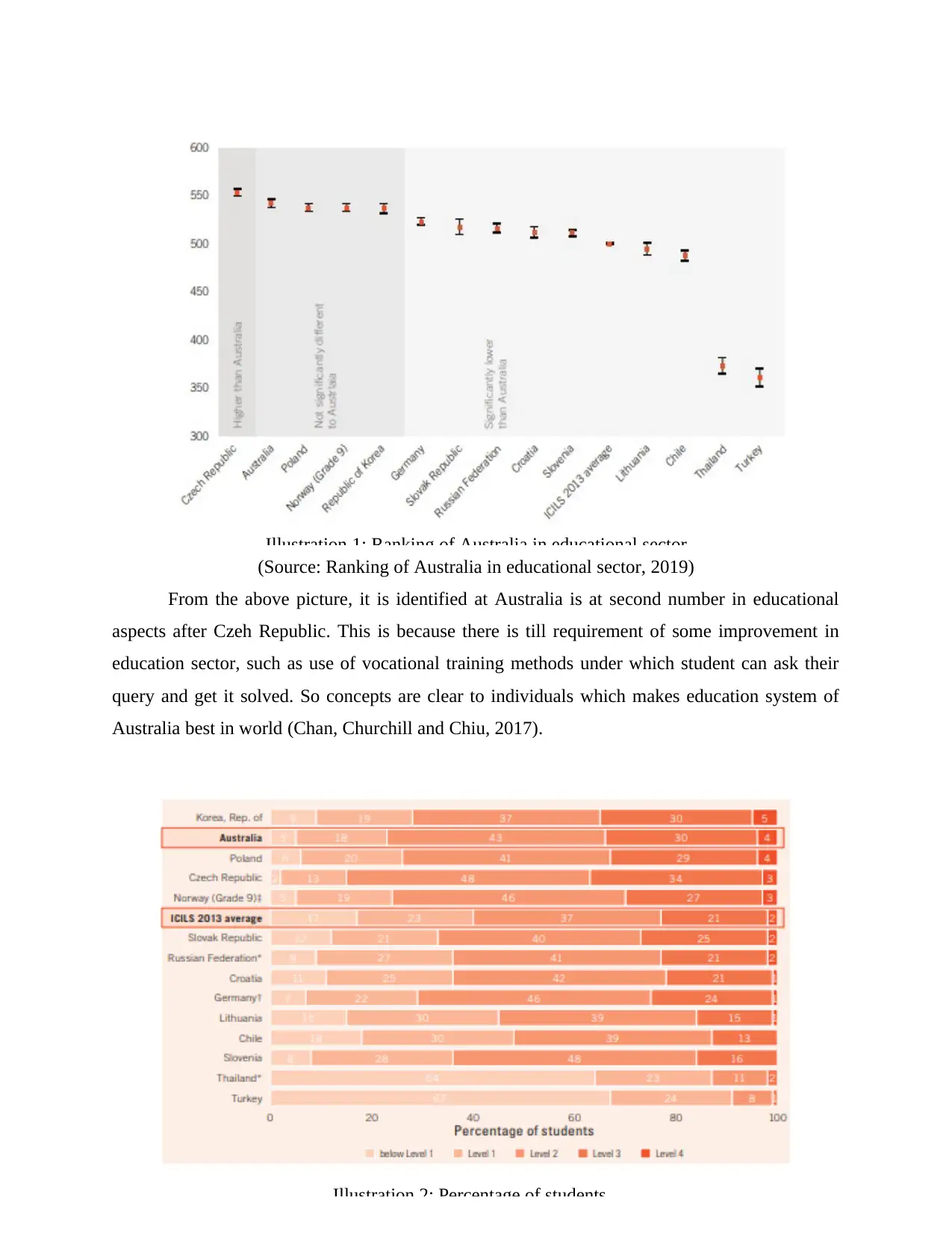
(Source: Ranking of Australia in educational sector, 2019)
From the above picture, it is identified at Australia is at second number in educational
aspects after Czeh Republic. This is because there is till requirement of some improvement in
education sector, such as use of vocational training methods under which student can ask their
query and get it solved. So concepts are clear to individuals which makes education system of
Australia best in world (Chan, Churchill and Chiu, 2017).
6
Illustration 1: Ranking of Australia in educational sector
Illustration 2: Percentage of students
From the above picture, it is identified at Australia is at second number in educational
aspects after Czeh Republic. This is because there is till requirement of some improvement in
education sector, such as use of vocational training methods under which student can ask their
query and get it solved. So concepts are clear to individuals which makes education system of
Australia best in world (Chan, Churchill and Chiu, 2017).
6
Illustration 1: Ranking of Australia in educational sector
Illustration 2: Percentage of students
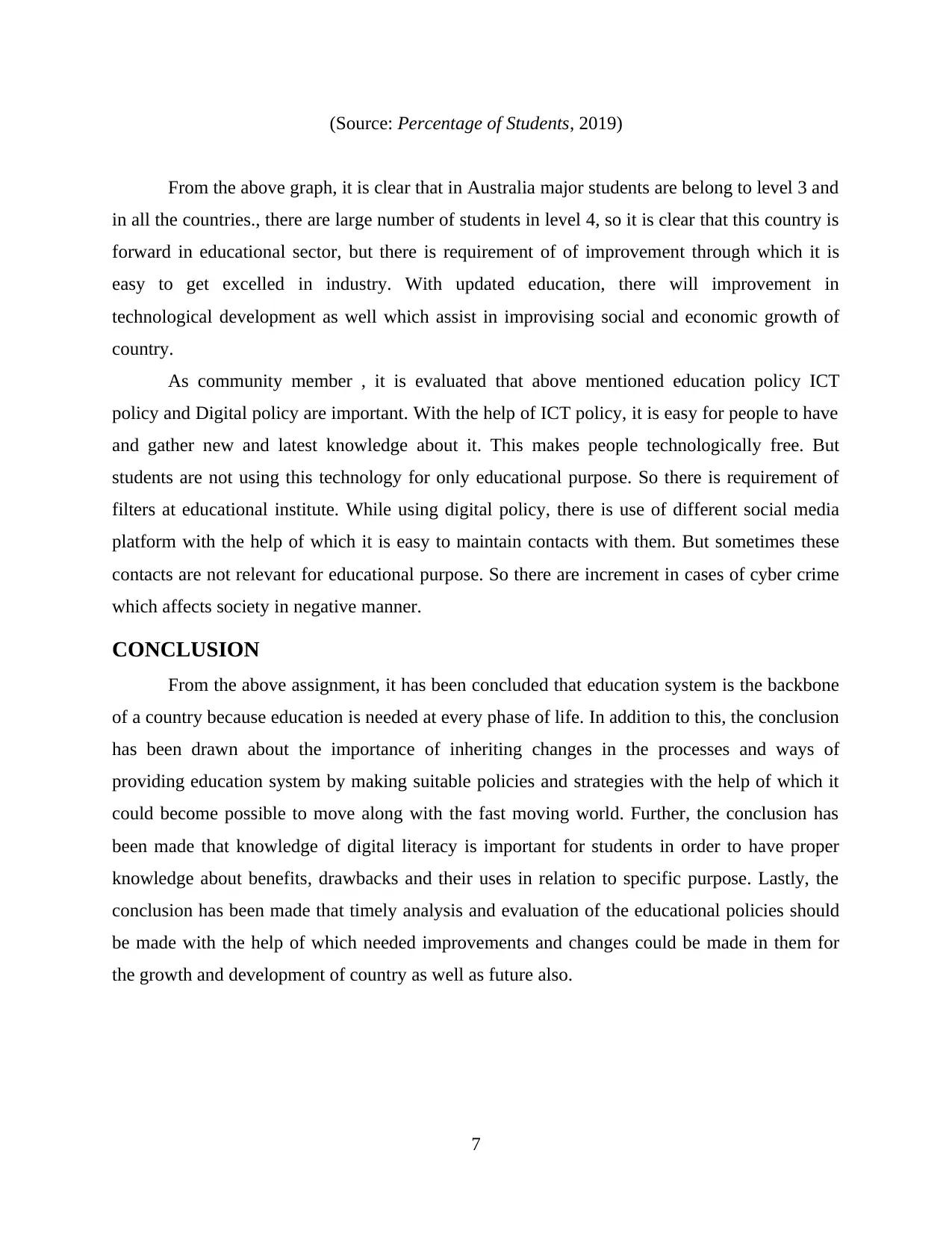
(Source: Percentage of Students, 2019)
From the above graph, it is clear that in Australia major students are belong to level 3 and
in all the countries., there are large number of students in level 4, so it is clear that this country is
forward in educational sector, but there is requirement of of improvement through which it is
easy to get excelled in industry. With updated education, there will improvement in
technological development as well which assist in improvising social and economic growth of
country.
As community member , it is evaluated that above mentioned education policy ICT
policy and Digital policy are important. With the help of ICT policy, it is easy for people to have
and gather new and latest knowledge about it. This makes people technologically free. But
students are not using this technology for only educational purpose. So there is requirement of
filters at educational institute. While using digital policy, there is use of different social media
platform with the help of which it is easy to maintain contacts with them. But sometimes these
contacts are not relevant for educational purpose. So there are increment in cases of cyber crime
which affects society in negative manner.
CONCLUSION
From the above assignment, it has been concluded that education system is the backbone
of a country because education is needed at every phase of life. In addition to this, the conclusion
has been drawn about the importance of inheriting changes in the processes and ways of
providing education system by making suitable policies and strategies with the help of which it
could become possible to move along with the fast moving world. Further, the conclusion has
been made that knowledge of digital literacy is important for students in order to have proper
knowledge about benefits, drawbacks and their uses in relation to specific purpose. Lastly, the
conclusion has been made that timely analysis and evaluation of the educational policies should
be made with the help of which needed improvements and changes could be made in them for
the growth and development of country as well as future also.
7
From the above graph, it is clear that in Australia major students are belong to level 3 and
in all the countries., there are large number of students in level 4, so it is clear that this country is
forward in educational sector, but there is requirement of of improvement through which it is
easy to get excelled in industry. With updated education, there will improvement in
technological development as well which assist in improvising social and economic growth of
country.
As community member , it is evaluated that above mentioned education policy ICT
policy and Digital policy are important. With the help of ICT policy, it is easy for people to have
and gather new and latest knowledge about it. This makes people technologically free. But
students are not using this technology for only educational purpose. So there is requirement of
filters at educational institute. While using digital policy, there is use of different social media
platform with the help of which it is easy to maintain contacts with them. But sometimes these
contacts are not relevant for educational purpose. So there are increment in cases of cyber crime
which affects society in negative manner.
CONCLUSION
From the above assignment, it has been concluded that education system is the backbone
of a country because education is needed at every phase of life. In addition to this, the conclusion
has been drawn about the importance of inheriting changes in the processes and ways of
providing education system by making suitable policies and strategies with the help of which it
could become possible to move along with the fast moving world. Further, the conclusion has
been made that knowledge of digital literacy is important for students in order to have proper
knowledge about benefits, drawbacks and their uses in relation to specific purpose. Lastly, the
conclusion has been made that timely analysis and evaluation of the educational policies should
be made with the help of which needed improvements and changes could be made in them for
the growth and development of country as well as future also.
7
⊘ This is a preview!⊘
Do you want full access?
Subscribe today to unlock all pages.

Trusted by 1+ million students worldwide
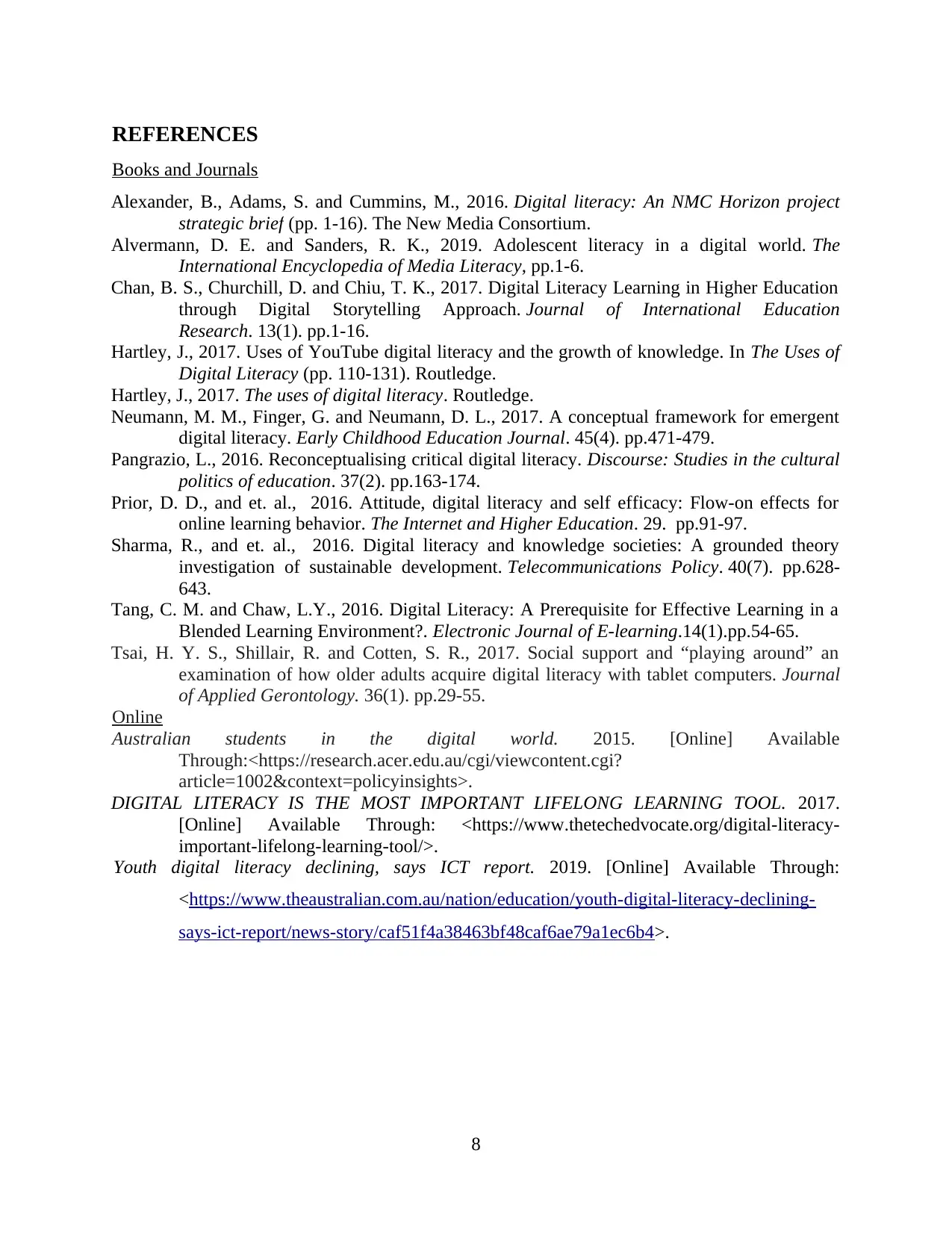
REFERENCES
Books and Journals
Alexander, B., Adams, S. and Cummins, M., 2016. Digital literacy: An NMC Horizon project
strategic brief (pp. 1-16). The New Media Consortium.
Alvermann, D. E. and Sanders, R. K., 2019. Adolescent literacy in a digital world. The
International Encyclopedia of Media Literacy, pp.1-6.
Chan, B. S., Churchill, D. and Chiu, T. K., 2017. Digital Literacy Learning in Higher Education
through Digital Storytelling Approach. Journal of International Education
Research. 13(1). pp.1-16.
Hartley, J., 2017. Uses of YouTube digital literacy and the growth of knowledge. In The Uses of
Digital Literacy (pp. 110-131). Routledge.
Hartley, J., 2017. The uses of digital literacy. Routledge.
Neumann, M. M., Finger, G. and Neumann, D. L., 2017. A conceptual framework for emergent
digital literacy. Early Childhood Education Journal. 45(4). pp.471-479.
Pangrazio, L., 2016. Reconceptualising critical digital literacy. Discourse: Studies in the cultural
politics of education. 37(2). pp.163-174.
Prior, D. D., and et. al., 2016. Attitude, digital literacy and self efficacy: Flow-on effects for
online learning behavior. The Internet and Higher Education. 29. pp.91-97.
Sharma, R., and et. al., 2016. Digital literacy and knowledge societies: A grounded theory
investigation of sustainable development. Telecommunications Policy. 40(7). pp.628-
643.
Tang, C. M. and Chaw, L.Y., 2016. Digital Literacy: A Prerequisite for Effective Learning in a
Blended Learning Environment?. Electronic Journal of E-learning.14(1).pp.54-65.
Tsai, H. Y. S., Shillair, R. and Cotten, S. R., 2017. Social support and “playing around” an
examination of how older adults acquire digital literacy with tablet computers. Journal
of Applied Gerontology. 36(1). pp.29-55.
Online
Australian students in the digital world. 2015. [Online] Available
Through:<https://research.acer.edu.au/cgi/viewcontent.cgi?
article=1002&context=policyinsights>.
DIGITAL LITERACY IS THE MOST IMPORTANT LIFELONG LEARNING TOOL. 2017.
[Online] Available Through: <https://www.thetechedvocate.org/digital-literacy-
important-lifelong-learning-tool/>.
Youth digital literacy declining, says ICT report. 2019. [Online] Available Through:
<https://www.theaustralian.com.au/nation/education/youth-digital-literacy-declining-
says-ict-report/news-story/caf51f4a38463bf48caf6ae79a1ec6b4>.
8
Books and Journals
Alexander, B., Adams, S. and Cummins, M., 2016. Digital literacy: An NMC Horizon project
strategic brief (pp. 1-16). The New Media Consortium.
Alvermann, D. E. and Sanders, R. K., 2019. Adolescent literacy in a digital world. The
International Encyclopedia of Media Literacy, pp.1-6.
Chan, B. S., Churchill, D. and Chiu, T. K., 2017. Digital Literacy Learning in Higher Education
through Digital Storytelling Approach. Journal of International Education
Research. 13(1). pp.1-16.
Hartley, J., 2017. Uses of YouTube digital literacy and the growth of knowledge. In The Uses of
Digital Literacy (pp. 110-131). Routledge.
Hartley, J., 2017. The uses of digital literacy. Routledge.
Neumann, M. M., Finger, G. and Neumann, D. L., 2017. A conceptual framework for emergent
digital literacy. Early Childhood Education Journal. 45(4). pp.471-479.
Pangrazio, L., 2016. Reconceptualising critical digital literacy. Discourse: Studies in the cultural
politics of education. 37(2). pp.163-174.
Prior, D. D., and et. al., 2016. Attitude, digital literacy and self efficacy: Flow-on effects for
online learning behavior. The Internet and Higher Education. 29. pp.91-97.
Sharma, R., and et. al., 2016. Digital literacy and knowledge societies: A grounded theory
investigation of sustainable development. Telecommunications Policy. 40(7). pp.628-
643.
Tang, C. M. and Chaw, L.Y., 2016. Digital Literacy: A Prerequisite for Effective Learning in a
Blended Learning Environment?. Electronic Journal of E-learning.14(1).pp.54-65.
Tsai, H. Y. S., Shillair, R. and Cotten, S. R., 2017. Social support and “playing around” an
examination of how older adults acquire digital literacy with tablet computers. Journal
of Applied Gerontology. 36(1). pp.29-55.
Online
Australian students in the digital world. 2015. [Online] Available
Through:<https://research.acer.edu.au/cgi/viewcontent.cgi?
article=1002&context=policyinsights>.
DIGITAL LITERACY IS THE MOST IMPORTANT LIFELONG LEARNING TOOL. 2017.
[Online] Available Through: <https://www.thetechedvocate.org/digital-literacy-
important-lifelong-learning-tool/>.
Youth digital literacy declining, says ICT report. 2019. [Online] Available Through:
<https://www.theaustralian.com.au/nation/education/youth-digital-literacy-declining-
says-ict-report/news-story/caf51f4a38463bf48caf6ae79a1ec6b4>.
8
1 out of 10
Related Documents
Your All-in-One AI-Powered Toolkit for Academic Success.
+13062052269
info@desklib.com
Available 24*7 on WhatsApp / Email
![[object Object]](/_next/static/media/star-bottom.7253800d.svg)
Unlock your academic potential
Copyright © 2020–2025 A2Z Services. All Rights Reserved. Developed and managed by ZUCOL.





